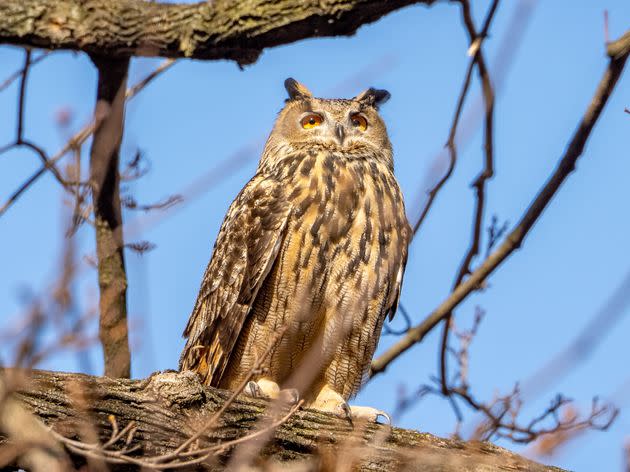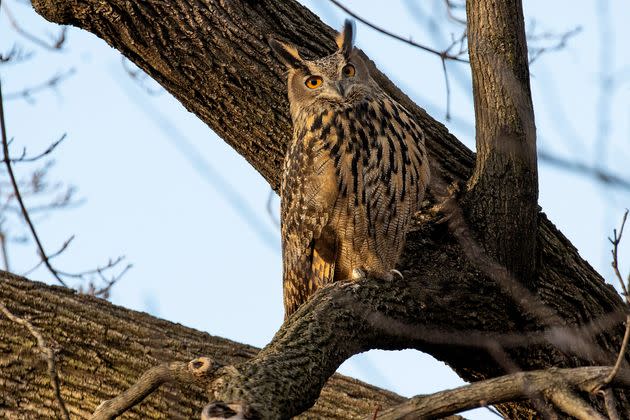Flaco, Owl Who Escaped Zoo And Soared New York City Skies, Has Died
Flaco, an owl who became a New York City icon after he flew the coop at the Central Park Zoo last year, has died.
“We are saddened to report that Flaco, the Eurasian eagle owl discovered missing from the Central Park Zoo after his exhibit was vandalized just over a year ago, is dead after an apparent collision with a building on West 89th Street in Manhattan,” the Wildlife Conservation Society, a nonprofit that manages the zoo, said in a press release Friday.

An undated image shows Flaco the owl surveying New York City.
Flaco appeared to have collided with a window, according to the Wild Bird Fund, a wildlife rehabilitation center that attempted to save the owl after the accident.
“We hoped only to see Flaco hooting wildly from the top of our local water tower, never in the clinic,” the nonprofit wrote.
Millions of birds are estimated to die every year by crashing into reflective glass windows ― a reason that environmental groups advocate for using bird-safe glass or taking other steps to deter collisions.
In Flaco’s case, the Wild Bird Fund noted that it’s not yet clear whether he was also suffering from the effects of rodenticide, which can build up in the bodies of predators that eat poisoned mice and rats. In 2021, a female owl named Barry was hit by a van in Central Park and was later found to have high levels of rat poison in her system, which likely impaired her ability to fly.
Flaco left his zoo enclosure behind on Feb. 2 of last year, after a still-unidentified person cut the mesh that had prevented him from flying away.

Flaco is pictured in a Central Park tree last year in New York City.
The owl had been born in captivity and arrived at the zoo as a fledgling. He remained there for 13 years before escaping and taking up residence in the surrounding trees of Central Park.
Since he had never lived in the wild, his escape was immediately followed by concerns that he would be unable to hunt and could starve to death. But as the zoo sent out teams attempting to capture Flaco, the owl was observed successfully catching and eating prey.
Flaco’s star was already on the rise, and public opinion began to skew toward a desire to let him remain free. The bird’s fame was fueled by David Barrett, who runs the popular birding account Manhattan Bird Alert on X and would frequently post photos of Flaco, as well as information related to his whereabouts.
We are heartbroken to report that Flaco the Eurasian Eagle-Owl has died tonight "after an apparent collision with a building on West 89th Street in Manhattan."https://t.co/96sws3KvDa
— Manhattan Bird Alert (@BirdCentralPark) February 24, 2024
Some others in the birding community argued that allowing a captive-raised, non-native animal to live free was irresponsible, warning that Flaco was likely not cut out for life on his own in the city and expressing concerns about possible impacts on native species.
Nevertheless, Flaco quickly became a local celebrity, with New Yorkers gleefully reporting sightings and sharing photos of the majestic bird of prey in Central Park and, when he began to fly farther afield, among the buildings of Manhattan.

Flaco is shown in Central Park on Feb. 15, 2023, in New York City.
New Yorkers and other devotees mourned his loss, sharing their favorite images and memories of Flaco on social media.
RIP free bird https://t.co/bzL4WZKmqe
— southpaw (@nycsouthpaw) February 24, 2024
I’m going to miss videos of Flaco looking into apartments. I always thought he was turning the table on all of those people who stared into his cage for years.
— Janet Johnson (@JJohnsonLaw) February 24, 2024
our true mayor pic.twitter.com/4RE2zfFKvn
— Mrs. Detective Pikajew, Esq. (@clapifyoulikeme) February 24, 2024
rip Flaco the owl. at least he got to taste freedom if only for awhile
— Katherine Krueger (@kath_krueger) February 24, 2024
Tear the building down. Right now. https://t.co/hclVzKhrqe
— Brandon (@blgtylr) February 24, 2024
We need a city-wide day of mourning, and I am not kidding. RIP Flaco. 🦉💔 https://t.co/BDsDuOfx8P
— Kelly Masked&Vaxxed Caldwell (@kkc212) February 24, 2024
RIP to a New York legend https://t.co/Xv82wS2nCA
— Jeff Coltin (@JCColtin) February 24, 2024
